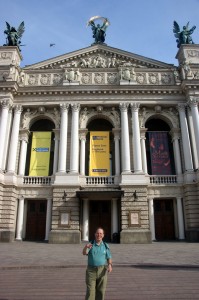
May 29, 2010
Professor Pana was right. I was in love with Romania. But that was yesterday’s news. And today I’m in Lvov, Ukraine (not the Ukraine), and I’m in Lvov with a new city.
Part of my joy comes from just being allowed in the country. With some free time in the airport in Timisoara, I thought I ought to do my homework on Lvov. I read a guide online, which stated that the city is underappreciated because foreigners need a visa to visit Ukraine. Sweat started to roll down my face, as I envisioned spending two days at the Lvov airport, unable to enter the country because I hadn’t applied for a visa. I wondered whether I could get one if needed at the airport, or whether I’d have to spend the time till my flight Monday in the never-never land in front of the customs desk. Happily, the web was incorrect (there’s a lesson there for all you believers in electronics!), and I made it to the hotel. And relieved because the airport, one of those Soviet-looking Stalin buildings (too much to tear down, said our Poland guide) had no amenities.
Then there was the second treat. The hotel I’m at is the Opera, across from a turn-of-the century (20th) palace of the arts, the Opera House. I inquired if there were any performances tonight. The concierge replied that the opera starts at six (it was 5:30), but he’d inquire. He called 5 minutes later to tell me I had a ticket (for around 8$). It was main floor for Verdi’s “Il Trovatore.” For those of you who know Verdi’s Anvil Chorus, it’s from that opera. The building itself was worth seeing, a beaux arts construction with about 1000 seats. It sits on the main river through town, which was concreted over and diverted underground. The performance was excellent. A dinner of vareneky (dumplings), TV with the locals to watch the Kiev-Romania match, and I’m a happy camper.